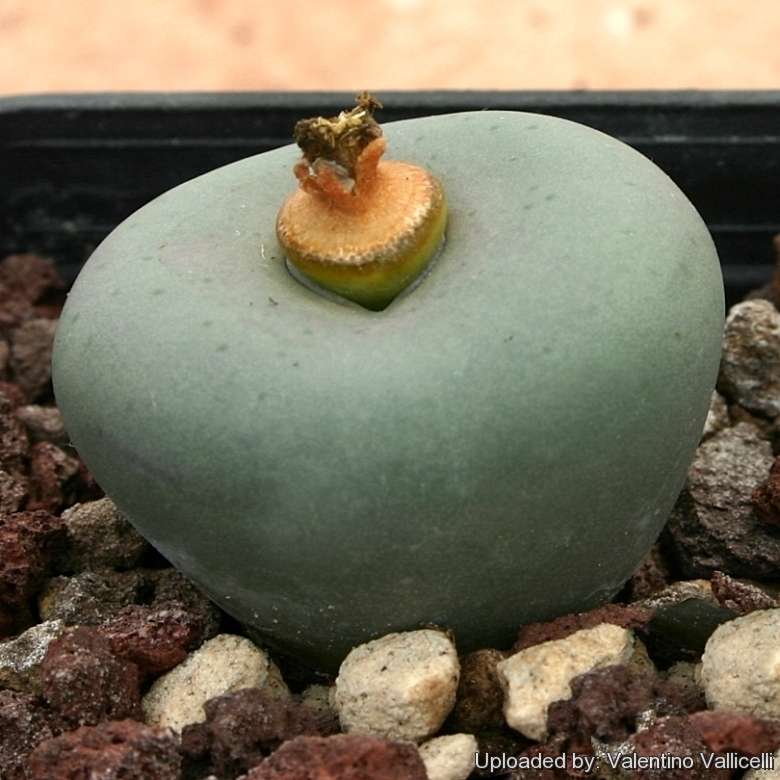Accepted Scientific Name: Conophytum calculus subs. vanzylii (Lavis) S.A.Hammer
Gen. Conophytum 267 1993 S.A.Hammer

Conophytum breve var. vanzylii (Conophytum calculus subs. vanzylii) Photo by: Valentino Vallicelli
SB1545 (Collector: Steven Brack) Locality: Areb, Springbok, Little Namaqualand, North-West Cape Province, South Africa
Origin and Habitat: Conophytum calculusSN|21981]]SN|21981]] subs. vanzylii occurs far to the northeast areal of the species, in the Bushmanland, North-West Cape Province, South Africa.
Synonyms:
See all synonyms of Conophytum calculus
Common Names include:
ENGLISH: Marble buttons, Living peebles
Description: Conophytum calculusSN|21981]]SN|21981]] subs. vanzylii is a local or morphological form of the globular-bodied Conophytum calculusSN|21981]]SN|21981]], which occurs far to the northeast, in the Bushmanland, and it differs in its epidermal colours and markings.
Note: Conophytum calculusSN|21981]]SN|21981]] and others related globular-bodied species represent the end of the line of development of Conophytums. Like Siamese twins, the single leaf-pair of a plant has become so closely fused together as to look like a pale-green globe. They are often called pebble or button plants as a result. It is obvious that the greater the reduction of the surface area, the greater the drought to which the plant is subjected in its native habitat.
Habit: Plants forming more or less wide and compact mats up to 15 cm diameter with age.
Bodies (paired leaves): Nearly perfectly spherical to somewhat laterally flattened, about 16-20 mm high and rather more across (up to 24 mm Ø), with only a tiny a cleft about 4 mm across, chalky greyish green, pale blue-green or purple blue in colour, without dark dots or stripes (rarely with very scanty spots) and sometimes ribbed. During the summer season, plants aestivate and the body is gradually replaced by a new young pair of leaves.
Flowers: Up to 12 mm in diameter, opening at night. Petals deep yellow or yellow-orange with brownish tips.
Blooming season: In autumn, it displays its flower from the ‘button hole’. To experience the fully opened bloom however, a night visit is required, as these heavily scented flowers are nocturnal to attract moth pollinators.
Subspecies, varieties, forms and cultivars of plants belonging to the Conophytum calculus group
- Conophytum calculus (A.Berger) N.E.Br.: has globular bodies without dark dots or stripes and yellow scented nocturnal flowers. Distribution: South Africa (Cape Province, southern Namaqualand from the Knersvlakte to Bitterfontein in the north. )
 Conophytum calculus subs. vanzylii (Lavis) S.A.Hammer: is a local or morphological form with slightly different epidermal colours and markings. Distribution: occurs far to the northeast, in the Bushmanland.
Conophytum calculus subs. vanzylii (Lavis) S.A.Hammer: is a local or morphological form with slightly different epidermal colours and markings. Distribution: occurs far to the northeast, in the Bushmanland.
Bibliography: Major references and further lectures
1) James Cullen, Sabina G. Knees, H. Suzanne Cubey “The European Garden Flora Flowering Plants: A Manual for the Identification of Plants Cultivated in Europe, Both Out-of-Doors” Cambridge University Press, 11/Aug./2011
2) Raimondo, D., von Staden, L., Foden, W., Victor, J.E., Helme, N.A., Turner, R.C., Kamundi, D.A. and Manyama, P.A. 2009. “Red List of South African Plants.” Strelitzia 25. South African National Biodiversity Institute, Pretoria.
3) Hammer, S. 1993. “The Genus Conophytum - A Conograph.” Succulent Plant Publications, Pretoria.
4) Hammer, S. 2002. “Dumpling and His Wife: New Views of the Genus Conophytum.” East Anglia Engraving Creative Colour Ltd, Norwich, England.
5) Ernst Van Jaarsveld, Ben-Erik Van Wyk, Gideon Smith “Succulents of South Africa: A Guide to the Regional Diversity” Tafelberg Publishers, Limited, 01/lug/2000
Cultivation and Propagation: Conophytum calculusSN|21981]]SN|21981]] is a "winter" grower which is most active from late winter until later spring and heading for summer dormancy. All the forms of Conophytum calculusSN|21981]]SN|21981]] are easy to grow.
Soil: Best in pots. Requires good drainage as it it is prone to root rot. It can grows outdoor in sunny, dry, rock crevices (protection against winter wet is required) It can also be cultivated in alpine house, in poor, drained soil.
Watering: It requires little water; otherwise its epidermis breaks (resulting in unsightly scars). Water minimally in summer, (only when the plant starts shrivelling), but it will generally grow even in summer if given water. Water regularly in winter after the previous year's leaves have dried up. Requires good drainage.
Remarks: Conophytum calculusSN|21981]]SN|21981]], start to produce obvious wrinkles when they need a drink and they can be used as marker plants to determine when the collection needs water.
Fertilization: Feed it once during the growing season with a fertilizer specifically formulated for cactus succulents (poor in nitrogen), including all micro nutrients and trace elements diluted to ½ the strength recommended on the label. It thrives in poor soils and need a limited supplies of fertilizer to avoid the plants developing excess vegetation, which is easily attacked by fungal diseases.
Exposure: Keep cool and shaded in summer, it needs full sun or light shade.
Temperature: Hardy to -2°C. Ensure a very good ventilation.
Repotting: Avoid to repot frequently. This plant may stay in the same pot for many years.
Uses: Container, rock garden.
Pests and diseases: It is vulnerable to mealybugs and rarely scale.
Propagation: It can be reproduced both by cuttings and seeds. Take the cutting from a grown-up mother plant. Each cutting must contain one or more heads along with a fraction of root. It is easily propagated by seed. The small seeds can be sown in pots of fine, well-drained sand, any time during the spring and summer months when temperatures are warm. Cover the seeds with a very fine layer of grit and water from below with a fungicide to prevent damping off. For the first 3-4 days cover the pots with a sheet of glass/clear perspex to keep the humidity levels high. Remove the glass and replace it with light shadecloth and mist once or twice a day for the next two weeks after which most seeds should have germinated. From then on mistings can be reduced to every second and then every third day as the little plants grow.











